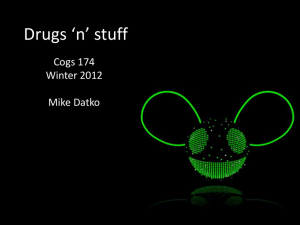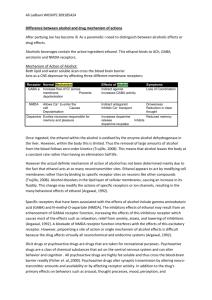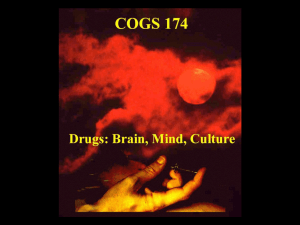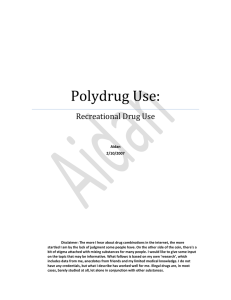Effect of MDMA Neurotoxicity Upon Its Conditioned Place
advertisement
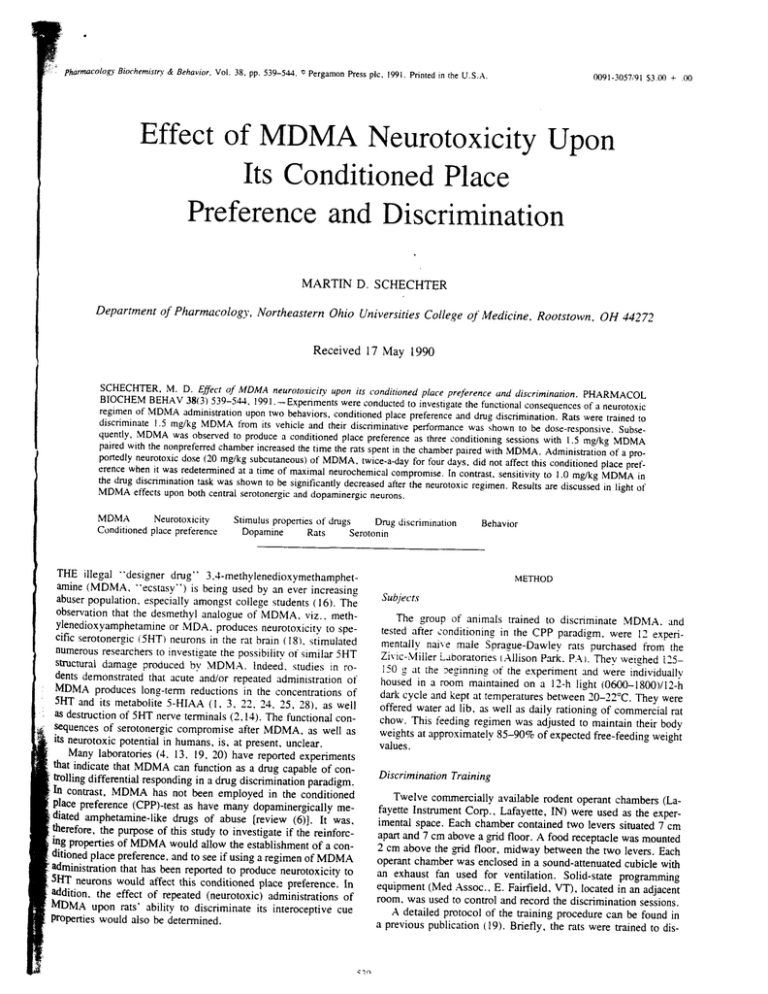
,r
!'! pharmacology
Biochemisto'&Behavior.Vol. 38. pp. 539-544.* PergamonPress plc, 1991.Printedin the U.S.A.
0091-3057/9153.00 + .00
Effect of MDMA Neurotoxicity Upon
Its Conditioned Place
Preference and Discrimination
MARTIN
Department
of Pharmacology,
Northeastern
D. SCHECHTER
Ohio Universities
Received
College
of Medicine.
Rootstown,
OH 44272
17 May 1990
SCHECHTER, M. D. Effect of MDMAneurotoxicityupon its conditioned place preference and discrimination. PHARMACOL
BIOCHEM BEHAV 38(3) 539-544, 1991.- Experiments were conducted to investigate the functional consequences of a neurotoxic
regimen of MDMA administration upon two behaviors, conditioned place preference and drug discrimination. Rats were trained to
discriminate 1.5 rog/kg MDMA from its vehicle and their discriminative performance was sho,,vn to be dose-responsive. Subsequently. MDMA was observed to produce a conditioned place preference as three conditioning sessions with 1.5 rog/kg MDMA
paired with the nonpreferred chamber increased the time the rats spent in the chamber paired with MDMA. Administration of a proportedly neurotoxic dose (20 mg/kg subcutaneous) of MDMA, twice-a-day for four days, did not affect this conditioned place preference when it was redetermined at a time of maximal neurochemical compromise· In contrast, sensitivity to 1,0 mg/kg MDMA in
the drug discrimination task was shown to be significantly decreased after the neurotoxic regimen. Results are discussed in light of
MDMA effects upon both central serotonergic and dopaminergic neurons.
MDMA
Neurotoxicity
Conditioned place preference
Stimulus properties of drugs
Drug discrimination
Dopamine
Rats
Serotonin
THE illegal "designer drug" 3,4-methylenedioxymethamphet-
·
[!_
_its
t
I
Bin
i
amine (MDMA, "ecstasy") is being used by an ever increasing
abuser population, especially amongst college students (16). The
observation that the desmethyl analogue of MDMA. viz.. methylenedioxyamphetamine
or MDA. produces neurotoxicity to specific serotonergic (5HT) neurons in the rat brain (18L stimulated
numerous researchers to investigate the possibility of similar 5HT
structural damage produced bv MDMA. lndeed, studies in rodents demonstrated that acute and/or repeated administration of
MDMA produces long-term reductions in the concentrations of
5HT and its metabolite 5-HIAA (1, 3, 22, 24, 25, 28), as well
as destruction of 5HT nerve terminals (2,14). The functional consequences of serotonergic compromise after MDMA, as well as
neurotoxic potential in humans, is, at present, unclear,
Many laboratories (4, 13, 19, 20) have reported experiments
that indicate that MDMA can function as a drug capable of controlling differential responding in a drug discrimination paradigm.
contrast, MDMA has not been employed in the conditioned
place preference (CPP)-test as have many dopaminergically meidiated amphetamine-like drugs of abuse [review (6)]. It was,
!:therefore, the purpose of this study to investigate if the reinforcilng properties of MDMA would allow the establishment of a conditioned place preference, and to see if using a regimen of MDMA
administration that has been reported to produce neurotoxicity to
5HT neurons would affect this conditioned place preference. In
'addition, the effect of repeated (neurotoxic) administrations of
MDMA upon rats' ability to discriminate its interoceptive cue
properties would also be determined,
Behavior
METHOD
Subjects
The group of animals trained to discriminate MDMA. and
tested after conditioning in the CPP paradigm, were 12 experimentally naive male Sprague-Dawley rats purchased from the
Zivic-Miller Laboratories {Allison Park. PA). They weighed [25150 g at the veginning of the experiment and were individually
housed in a room maintained on a 12-h light (0600-1800)/12-h
dark cycle and kept at temperatures between 20-22°C. They were
offered water ad lib, as well as daily rationing of commercial rat
chow. This feeding regimen was adjusted to maintain their body
weights at approximately 85-90% of expected free-feeding weight
values.
Discrimination Training
Twelve commercially available rodent operant chambers (Lafayette Instrument Corp., Lafayette, IN) were used as the experimental space. Each chamber contained two levers situated 7 cm
apart and 7 cm above a grid floor. A food receptacle was mounted
2 cm above the _q'id floor, midway between the two levers. Each
operant chamber was enclosed in a sound-attenuated cubicle with
an exhaust fan used for ventilation. Solid-state programming
equipment (Med Assoc.. E. Fairfield, VT), located in an adjacent
room. was used to control and record the discrimination sessions.
A detailed protocol of the training procedure can be found in
a previous publication (19). Briefly, the rats were trained to dis-
540
SCHECHTER
criminate MDMA (1.5 mg/kg) from vehicle (V; distilled water)
in a two-lever, food-motivated operant task. Prior to the initiation
of training, one lever was designated as the "vehicle lever" and
the other lever as the "MDMA lever." Twenty min prior to each
generates EDso values. The quantitative data were calculated and
analyzed with a Student's paired t-test with p<0.05 chosen as the
criterion for significance.
training session, the food-deprived rats received an intraperitoneat (IP) injection (1 mi/kg volume) of either MDMA (1.5 mg/
ml) or V. After MDMA administration, responses on the MDMA
lever resulted in food reinforcement (45 mg Noyes food pellet),
whereas responses on the vehicle lever had no programmed consequence, Likewise, responses on the vehicle lever following V
administration produced reinforcement. The reinforcement schedule was set at a fixed ratio of 10 (FR 10), i.e.. 10 state (either
MDMA or vehicle)-appropriate lever responses yielded one reinforcement; this reinforcement schedule was attained by beginning
on an FR 1 schedule and gradually increasing the reinforcement
requirement over 6 days until an FR, 10 schedule was reached,
Once this occurred, daily sessions were conducted until animals
had made 400 responses upon the state-appropriate lever. Trainlng sessions were conducted once per day according to the twoweek repeating schedule: MDMA, V, V, MDMA, MDMA; V,
MDMA, MDMA. V, V, where V = vehicle and MDMA=trainlng dose of 1.5 mg/kg, The training schedule was continued until
the first lever pressed ten times was state-appropriate in eight of
ten consecutive daily sessions. When this criterion was attained,
the number of the first session of the ten consecutive sessions was
the measurement referred to as the sessions-to-criterion
(STC I).
The animals were required to choose the state-appropriate lever
on one additional set of 8 of l0 consecutive sessions; this measurement constituted the sessions-to-criterion 2 (STC 2).
Conditioned Place Preference Procedure
Dose-Response Effect of MDMA
After all the rats attained the training criterion and were thus
judged able to discriminate between 1.5 rog/kg MDMA and its
vehicle, the rats received various doses of MDMA (dose-response:
DR) different from the training dose according to the following
biweekly schedule: MDMA-DR_-V-DR2-MDMA,DR2-V-DR
_MDMA-DR3, etc., where MDMA=the
MDMA training dose:
V = vehicle: DR_ = one other dose of MDMA: DR, = second other
dose of MDMA, etc. Doses were administered IP at 20 rain prior
to testing and, on these test days. the animals were allowed to
lever press until 10 responses were made on either of the two levers. At that time, the rat was immediately removed from the
operant test chamber without receiving reinforcement and placed
into its home cage in order to preclude any reinforcement /trainlng) after a dose different than the 1.5 rog/kg MDMA training
dose. MDMA, in doses of 0.5, 0.75, and 1.0. was administered
on two occasions with one test session following a maintenance
session with 1.5 mg/kg MDMA and the other following a maintenance session with vehicle. During these maintenance sessions,
the lever first pressed ten times by the animal was considered as
the "selected"
lever, the animal was then allowed to make 400
responses upon the state-appropriate lever and, thereby (on the
FR 10 schedule), received 40 reinforcements. This dose-response
procedure allowed calculation of the dose of MDMA that produced 50% discriminative performance, i,e., the EDso value,
The lever pressed ten times was designated the "selected" lever. The percentage of rats selecting the lever appropriate for
MDMA was the quantal measurement of discrimination. In addition, the number of lever-presses made upon the MDMA lever
divided by the total number of presses on the MDMA and vehicle levers at the time that the tenth response was made on either
lever, x 100, constitutes the quantitative measurement. The quantal
data were analyzed by application of the method of Litchfield and
Wilcoxon (10) which employs probits vs. log-dose effects and
The apparatus used in this paradigm consisted of two modular
testing chambers (Model No. 85000, Lafayette Instrument Co.,
Lafayette, IN) each measuring 30 × 20.5 x 18 cm and connected
by a central comdor measuring 30 x 19.5 × 20 cm. These test
modules were covered by a translucent Plexiglas top which al.lowed light from either a white or red light bulb into the chamber. The top of each of the three units could be opened to permit
entry, or removal of the rat. One of the modules consisted of a
black smooth Plexiglas floor and was illuminated by a red light.
The other module was lighted with a white buJb and had a grid
floor with wood shavings placed under this floor. These physical
differences allowed for distinction by three senses, viz., tactile
(floors}, visual (lighting) and olfactory, (presence vs. absence of
"wood" smell). The central corridor, the choice area, was gray
and nondistinctive. All testing was carried out between l l001600 h in a darkened laboratory, with a source of "white noise."
The conditioning sequence consisted of three phases. The first
phase, the preconditioning phase, was three days in duration, On
these days the animal was placed into the gray choice area and
allowed free access to both test modules tot a 15-rain period. The
apparatus was thoroughly washed between rats to eliminate olfactory cues. The last day of preconditioning, i.e., day 3, constituted
the baseline preference day. The cumulative time that the rat had
at least two front paws in either the "black" (red-lighted) or
"white" (-lighted) compartment was measured by observation
through a one-way glass window on the side of each module.
The next phase was eight days of conditioning trials. After the
baseline day (day 3), the side referred to as the nonprelerred (NP)
was determined and it was this side that was paired with MDMA.
On every other day the rat was administered 1.5 rog/kg MDMA
IP and returned to its home cage for 10 rain to allow for maximai central efficacy of the drug. Alter this time, it was placed
into the nonpreferred side for a 3()-rain period. The rat was confined to that side by the insertion of panels that prevented its
egress. On alternate days, the animal was administered (IP) an
equal volume ti mi/kg) of V and was placed into the opposite
_pret'erred: P) side at the same postadministration tm_e and for the
same 50 min duration of confinement.
Alter the eight pairings, /'our with 1.5 rog/kg MDMA and four
with its vehicle, the last phase, the preference test, '*'as conducted.
The same parameters were used as on da,,' 3, i.e.. the rat (without being injected) was placed into the choice area and allowed
free access to the entire test apparatus for a 15-rain period during
which the total time spent in each modular environment was recorded.
The actual measurements were the number of s in which the
animals had at least two paws i-n either chamber during the 15rain test periods on days 3 and 12. These number of s did not
generally add up to 900 s (60 s x 15 min) as the time that the
animal spent in the choice area was not included. After the conditioning trials, the amount of time spent on a nonpreferred side
was determined and was .compared to baseline. The second measurement used was the difference (scores) between the time spent
in the nonpreferred side and the amount of time spent in the preferred side ("NP-P").
This second measurement allows for consideration of data on the amount of time spent in the side originally
preferred at baseline and, therefore, the side paired (during four
conditioning sessions) with V. These two measurements were
subjected to analysis of variance (ANOVA) with two repeated
NEUROTOXICITY
AND BEHAVIOR
541
TABLE
l
TABLE
2
scHEDULE OF SUBCUTANEOUS
ADMINISTRATION
OF SALINE OR A
HIGH, NEUROTOXIC DOSE (20 rog/kg) OF MDMA (MDMAtx) AND
SESSIONS-TO-CRITERION
IN RATS (n = 11 ) TRAINED
TESTING OF CONDITIONED
PLACE PREFERENCE AND DISCRiMINATION
TO LOWER DOSES OF MDMA
Day
a,m.
Series I/Series II
p.m.
Series I/Series II
I
2
3
4
Saline/MDMAtx
Saline/MDMAtx
Saline/MDMAtx
Saline/MDMAtx
Saline/MDMAtx
Saline/MDMAtx
Saline/MDMAtx
Saline/MDMAtx
13
14
15
-vehicle
--
1.0 MDMA
1.5MDMA
0.5MDMA
16
17
18
19
20
vehicle--Pside
MDMA--NP side
vehicle--Pside
MDMA--NP side
Preference Test
measures, i.e,, baseline and preference tests in s. The F ratio
comparisons were calculated for both the NP and the NP-P mensurements and were followed by individual comparisons with the
Newman-Keul's post hoc test to determine which measurements
differed. Subsequently, a Student's t-test, using paired data, was
conducted to compare baseline and preference test measurements.
Saline and MDMA Neuroto,ric Regimen
J
After the first discriminative dose-response relationship was
determined and followed by the first CPP-test, a regimen of
morning and afternoon subcutaneous (SC) administrations of saline was given over a four-day period: this regimen ended ten
days prior to redetermining the dose-response relationship and 13
This
days prior to redetermining the conditioned place preterence,
regimen was intended to investigate if saline administrations twicea-day for 4 days, as well as the absence of training for 10 days,
would affect discrimination of MDMA. As the first dose-response
relationship for MDMA (above) indicated that 0.75 and 1.0 mg/
kg produced relatively similar quantal measurements (59.1 and
63.6%, respectively), the doses to be used in the dose-response
relationship after repeated saline administration were chosen to be
0.5, 1.0 and 1.5 mg/kg,
Once the stability of the dose-response relationship after multiple subcutaneous saline injection was determined, the next phase
of the experiment was to administer a neurotoxic dose (20 mg/kg)
of MDMA SC twice-a-day for 4 days; a regimen reported to produce 5HT neurotoxicity in animals sacrificed 14 days after its
initiation (2,3). The regimen used after saline and MDMA, as
well as the sequence of dose-response discrimination and conditioned place preference experiments is detailed in Table t, Series
I refers to the saline regimen and Series II denotes the 20 rog/kg
MDMA administrations over a 4-day period. In each case, the
rats went without any training/testing until the 13th day when, in
the afternoon, 1.0 mg/kg MDMA was tested in extinction. This
AND DOSE-RESPONSE
RELATIONSHIP
TO DISCRIMINATE
1.5 rog/kg ( *- )MDMA
FROM ITS VEHICLE
S-T-C:
(+-S.D.)
No. 1. 9.2 (8.1)
No.2. 21.8,
(7.43
Range: 2-25 sessions
: 12-35sessions
Dose-Response
Dose MDMA
(rog/kg)
1.5
1.0
0.75
0.5
0.0(vehiclel
EDso
(95 C.L.)
Quantal
86,4
63.6
59.1
27.3
18,2
0.72 rog/kg
(0,57--0,9l)
Quantitative (S.D./
74.7 16.25
61.6
(10.2)
57.6 (3.3)
31.5 (2.6)
21.4 (0.4t
was followed on day 14 with a nonreinforcedvehicle test in the
morning and a trial with 1.5 mg/kg MDMA (training dose) in the
afternoon. Lastly, the afternoonsession of the 15thday was conducted 20 min after administration of 0.5 rog/kg MDMA. In all
of these four tests, the rat was immediately removed upon making I0 responses on either of the two levers. On the next day (day
163 the vehicle was administered IP and the animals were placed
10 min later for a 30-rain period of confinement in their preferred
side (P). On the next day, 1.5 mg/kg MDMA was injected and
the rat was confined to its nonpreferred (NP) side for the same
duration. This was repeated again on the next two (the 18th and
19thl days. The 20th day was used as a preference test in which
the rat received no injection and was allowed to freely enter elther one of the two modules for a 15-min period. Between Series
[ and II, i.e.. after saline administration and prior to repeated
MDMA treatment, the rats were retrained with two vehicle and
two MDMA discrimination sessions, on alternate days. to ensure
that they were capable of discriminating between MDMA and its
vehicle.
RESULTS
.-ks previously reported _4. 13, 19. 201, MDMA is a psychothat is
of
differential
active drug
capable
controlling
responding
in a drug discrimination paradigm. Accordingly, rats were readily
trained to discriminate 1.5 rog/kg racemic MDMA from its distilled water vehicle, with the first of ten consecutive sessions in
which the state-appropriate lever was chosen on at least 8 occasions starting on a mean of 9.2 sessions (STC 1: Table 2). The
training criterion of 8 out of l0 consecutive correct sessions was
met for the second time at a mean of 21.8 sessions and all rats
were judged able to discriminate between MDMA and its vehicle
after 45 training sessions. Once all rats reached criterion pefformance, doses of MDMA lower than the training dose were administered during test sessions. During these dose-response
experiments, one of the 12 rats died of causes unrelated to the
experiment and the results reflect this fact (n = 11). The training
dose (1.5 mg/kg) of MDMA produced 86.4% of first lever selections (pressed 10 times first) upon the MDMA-appropfiate lever
(Table 2). When 1.0 rog/kg MDMA was administered, 63.6% of
first selected lever choices were on the MDMA lever and lowerlng the dose to 0.75 and 0.5 rog/kg reduced the percentage of first
choice lever selection upon the MDMA lever to 59.1 and 27.3%,
respectively. Administration of vehicle during interspersed main-
542
SCHECHTER
TABLE
3
TABLE
4
DISCRIMINATIVE
PERFORMANCE
AFTERVARIOUSDOSESOF
MDMA13-15DAYSAFTER20 mg/kgMDMAOR SALINE
TWICE-A-DAY FOR FOUR DAYS
EFFECTOF REPEATEDSALINEOR MDMA120mg/kglADMINISTRATIONS
UPONCONDITIONED
PLACEPREFERENCE
TO 1.5rog/kgMDMA
AfterSaline
Dose
(mg/kg)
Quantal
AfterMDMA
Quantitative
(SEM)
Quantal
Baseline
90.9
81.8
18.2
0.71 rog/kg
(0.52-0.98)
80.6(6.3)
80.1(7.9)
25.4 (7.1)
20th day
Saline
20th day
MDMA
Quantitative
(SEM)
A. Mean Time (s- SD) Spent in Nonpreferred (NP) Side
221.5 (82.1)
1.5
1.0
0.5
EDso
(95%C.L.)
MDMA
72.7
61.6 (7.9)
45.5
43.6(11.8)*
9.1
18.2 (8.2)
1.07
(0.76-1.49)
*Significantlylowerthan quantitative measurementfor 1.0 mg/kg MDMA
after multiple saline administrations, p<0.01 (paired t-test),
tenance trials produced 18.2% of selected lever choices on the
MDMA lever or (to look at it a different way) 81.8% upon the
vehicle-appropriate lever. These results allowed for an ED,_ value
of 0.72 mg/kg (95% confidence limits: 0.57-0.91).
The results of testing 0.5-1.5 mg/kg MDMA after repeated
(eight) treatments with saline are presented on the left side of
Table 3. When 1.0 mg/kg MDMA was tested on the afternoon of
the 13th day, nine of the rats selected the MDMA lever. This
yields a quantal measurement of 81.8% and a quantitative measurement of 80.1% was determined. In the morning session of the
next day one rat chose the MDMA lever after vehicle (data not
shown) and, in the afternoon session, following the training dose
of 1.5 mg/kg MDMA, ten of the eleven animals chose the MDMA
lever. On the last day of postsaline testing, i.e., day 15, adminis(ration of 0.5 mg/kg MDMA resulted in two of the animals
choosing the MDMA-appropriate lever,
Following a (second) determination of conditioned place preference (below) and a period of 4 days of retraining, consisting of
two maintenance (reinforced) sessions with saline alternated with
two 1.5 mg/kg MDMA maintenance sessions, the animals received 20.0 mg/kg MDMA SC twice-a-day for tour days. The
results of testing the same doses of MDMA 13, 14 and 15 davs
after initiation of this regimen appear on the right side of Table
3. Eight of the animals (72.7%) selected the MDMA lever after
1.5 rog/kg and following 1.0 mg/kg, tested on the 13th day. the
number of animals selecting the MDMA lever dropped to five of
eleven (45.5%). After vehicle administration, none of the rats
selected the MDMA lever. On the last day of post-MDMA testlng, 0.5 rog/kg MDMA administration resulted in only one rat
choosing the MDMA-correct lever. When the quantitative measurements are compared following the MDMA neurotoxic regimen to those measurements following the repeated administrations
of saline, there is a significant decrease in discriminative performance after 1.0 mg/kg MDMA (p<0.01; paired t-test) indicating
that the generalization of this dose for the training dose was affected,
The results of conditioned place preference experiments appear in Table 4. The first exposure of rats trained in the drug discrimination paradigm to the novel situation in the modules used
for the conditioned place preference test resulted in a mean of
221.5 s spent by the 11 animals in the least (non-)preferred side
("Baseline"; Table 4A). In addition, the animals spent a mean of
455.5 s in the preferred side and this is evident in the difference
score (NP-P data in Table lB) where 221.5 (s spent in NP side)
minus 455.5 (s spent in P side) appears as -234.0 s. After 4
pairings with each of 1.5 mg/kg MDMA and its vehicle, this
group of rats spent an average of 469.3 s in the nonpreferred
469.3 (144.5)
487.0 (114.3)
492.8 (223.2)
B. Difference Scores: Mean Time (s _ SD) in NP Side Minus P Side
-234.0 (232.7)
228.2 (254.2)
251.5 (204.3)
side; a significant (F= 11.52, ANOVA, p<0.01)
235.9 (3739)
increase in time
spent.
When a second CPP test was conducted following the repeated
saline administration (represented bv Series I in Table l I, the
preference test on day 20 ["20th day (post-) saline" in Table 4]
indicated a nonsignificant increase in time spent in the nonpreferred side, i.e.. 487.0 s on the average. Likewise, a third CPPtest conducted on the 20th day following the initiation of repeated
neurotoxic MDMA dosing (Series II in Table 1) resulted in a
mean of 492.8 s spent in the nonpreferred side: nonsignificantly
different from that seen with the first or the postsaline MDMA
preference determination.
DISCUSSION
Like other drugs of abuse, such as amphetamine and cocaine,
MDMA has been shown to produce conditioned place preference.
The former drugs, as well as others that include bupropion, methylphenidate, nomifensine and apomorphine, have in common
the ability to facilitate dopamine transmission either by stimulatlng release, preventing its reuptake or directly stimulating dopamine receptors (6). This relationship has led to the suggestion that
the rewarding properties of the drugs, as they are measured by the
conditioned place preference test. may be mediated by central
dopamine. This hypothesis is evidenced by the ability of specific
dopamine receptor antagonists, or specific neurotoxin lesions of
dopaminergic neurons, to block the drug-induced conditioned
place preference (6). The present study is the first in the literature to show that the Schedule I dru_ MDMA can produce conditioned place preference in the CPP-task and suggests the
possibility that this behavioral effect of MDMA is mediated by
dopaminergic neurons. This hypothesis has been suggested by
research in this (20), as well as many other laboratories (5. 7, 8,
11, 23, 27, 29).
The methodology used in the present study infers that multipie CPP-tests, as they are employed to indicate animals' prefer-'
ence (or aversion) to a particular drug, do not change simply as a
consequence of the time between CPP-tests. This inference has
been addressed in a study investigating the capacity of morphine
to establish a conditioned place preference in which the animals'
preferenceswereestablishedand the CPP-testwas then repeated
three more times for a total of 4 tests over a one-month period.
The results indicate that as long as the subjects are placed during
continued conditioning on each side of the chamber an equal
number of times, they show no particular preference for the side
of conditioning across multiple tests in the apparatus (17). This
stability in preference after multiple CPP tests has also been shown
to occur with intraperitoneal cocaine in which tests were run 4, 7
and 30 days after the initial CPP-test (12). In the present study,
the initial preference for MDMA, measured prior to repeated administrations of either saline or a neurotoxic dose of MDMA, was
maintained after these two manipulations: thus the neurotoxic
',
MDMANEUROTOXICITY
ANDBEHAVIOR
_
regimen of MDMA
for the drug.
did not appear
to affect
animals'
543
preference
preference observed in the conditioned place preference paradigm
may be mediated by the dopaminergic effects of MDMA which,
In contrast, there was a decrease in the animals'
ability to
discriminate
the interoceptive cues produced by MDMA. In fact,
discrimination
of the intermediate
dose of (l.0 mg/kg) MDMA
was shown to be significantly decreased after the MDMA chronic
regimen when compared to results postsaline.
Initially, the rats
learned to discriminate
1.5 rog/kg MDMA and administration/
testing of lower doses indicated a response gradient that was
dose-responsive.
The EDso value was 0.72 mg/kg; remarkably
similar to that reported previously
in this laboratory,
i.e., 0.73
after serotonin neuronal degeneration,
may increase. In the case
of MDMA discrimination,
the 5HT degeneration
may, in fact,
have compromised
the animals'
ability to discriminate
the interoceptive cue which more than likely is mediated by serotonergic
mechanisms in the brain (20).
Repeated,
orally administered
MDMA,
at 10 mg/kg for 4 consecutive days, was recently shown to have no significant effect
upon rat behaviors,
such as emergence,
hot plate response,
auditory startle and complex
maze behavior,
when tested 2-4 weeks
nag/kg (19), and to the
other laboratory
using
Using a dose and
ously shown to produce
days after its initiation
criminate MDMA and
EDso value of 0.79 mg/kg reported in ana similar paradigm
(13).
regimen of MDMA administration
previsignificant 5HT neuronal
degeneration
14
(3), a decrease in the rats' ability to disa negligible change in their preference
was
after administration
(26). These authors suggest that the tests used
in their study may not have been adequately
sensitive enough to
detect the functional consequences
of 5HT degeneration
produced
by MDMA. It appears that drug discrimination
as employed herein
is sensitive enough to detect the neurotoxic effects of MDMA on
a distinctly
trained behavior
in the rat. Most recently (2 Il a regi-
observed.
A recent report (9) indicated
that a similar repeated
regimen of MDMA, to deplete 5HT levels in the brain, produced
an increase in the psychomotor
stimulant-like
effects of MDMA.
These authors suggest that the depletion of 5HT by the repeated
administrations
of MDMA acts to reduce the inhibitory
influence
of 5HT and, thus allows MDMA, when tested 14 days later, to
exert a stronger psychomotor effect: an action thought to be me-
men of administration
of fenfluramine,
a drug with potential
for
serotonin neurotoxicity,
was shown to have the opposite effect on
fenfluramine discrimination,
i.e., the animals were shown to have
increased sensitivity to various doses of this agent.
diated by dopaminergic
systems. The same reciprocity
between
5HT and dopamine
in the discriminative
properties
of MDMA
has previously
been suggested 120) and this neurotransmitter
balance may explain the results of the present experiments
using
drug discrimination
and conditioned
place preference.
Thus the
The author would sincerely like to thank Denise McBumey for her
continued expertise in the conduct of these experiments, Karen Kelley for
processing the words contained in the manuscript and the National Institute on Drug Abuse for providing the MDMA, as well as the funds through
grant No. 04801.
ACKNOWLEDGEMENTS
REFERENCES
1. Battaglia. G.: Yeh, S. Y.; De Souza, E. B. MDMA-induced neurotoxicity: Parameters of degeneration and recovery of brain serotonin
neurons. Pharmacol. Biochem. Behav. 29:269-274: 1988.
2. Banaglia, G.; Yeh, S. Y.; O'Hearn, E.; Molliver, M. E.; Kuhar. M.
J.; De Souza, E. B. 3.4-methylenedioxymethamphetamine
and 3.4methylenedioxyamphetamine
destroys serotonin terminals in rat brain:
quantification of neurodegeneration by measurement of [_H] paroxetine-labeled serotonin uptake sites. J. Pharmacol. Exp. Ther. 242:
91I-916:1987.
3. Commins. D. L.: Vosmer, G.: Virus. R. M.: Woolverton, W.L.:
Schuster. C. R.: Selden. L. S. Biochemical and histological evidence
that methylenedioxymethamphetamine
{MDMA) is toxic to neurons
in the rat brain. 1. PharmacoL Exp. Ther. 241:338-345: 1987.
4. Gtennon. R. A.: Misenbeimer, B. R. Stimulus et'lects of N-monoethyl-143.4-methylendioxyphenyl)-2-aminopropane
(MDE) and Nhydroxy- 1-13.4-methylendioxyphenyl)-2-aminopropane
(N-OH MDA)
in rats trained to discriminate MDMA from saline. Pharmacol. Biochem. Behav. 33:909-912: 1989.
5. Gold, L. H.; Hubner. C. B.; Koob. G. F. A role for the mesolimbic
dopamine system in a psychostimulant actions of MDMA. Psychopharmacology (Berlinl 99:40-47; 1989.
6. Hoffman, D. C. The use of place conditioning in studying the neuropharmacology of drug reinforcement. Brain Res. Bull. 23:373-387;
1989.
7. Hubner, C. B.; Bird, M.; Rassnick, S.; Kometsky, C. The threshold
lowering effects of MDMA (ecstasy) on brain-stimulation reward,
Psychopharmacology {Berlin) 95:49-51; 1988.
8. Johnson, M. P.; Hoffman, A. J.: Nichols, D. E. Effects of the enantiomers of MDA, MDMA and related analogues on [aH]serotonin
and [3H]dopamine release from superfused rat brain slices. Eur. J.
Pharmacol. 132:269-276; 1986.
9. Li, A. A.: Marek, G. J.: Vosmer. G.; Selden, L. S. Long-term central 5-HT depletions resulting from repeated administration of MDMA
enhances the effects of single administration of MDMA on schedulecontrolled behavior of rats. Pharmacol. Biochem. Behav. 33:64l648: 1989.
10. Litchfield, J. T.; Wilcoxon, F. A simplified method of evaluating
dose-eftkct experiments. J. Pharmacol. Exp. Ther. 96:99-106; 1949.
I l, Matthews, R. T.: Champney. T. H.; Frye, G. D. Effects of ( _ /
3,4-methylenedioxymethamphetamine
(MDMA) on brain dopaminergic activity in rats. Pharrnacol. Biocbem. Behav. 33:741-747; 1989.
12. Nomikos, G. G.: Spyraki, C. Cocaine-induced
place conditioning:
importance of route of administration and other procedural variables.
Psychopharmacology
(Berlin} 94:119-125; 1988.
13. Oberlender. R.: Nichols. D. E. Drug discrimination studies with
MDMAand amphetamine.Psycbopharmacology_Berlin) 95:71-76:
1988.
14. O'Hearn. E.: Battaglia. G.: De Souza. E. B.: Kuhar, M. J.: Molliver. 5.t.E. Methylenedioxyamphetamine
(MDA) and methylenedioxymethampnetamine
IMDMAI cause seiecnve arc,anon of
serotonergic axon terminals in the forebrain: immunocytochemical
evidence for neurotoxicity. J. Neurosci. 8{8):2788-2830:
1988.
15. Overton. D. A. Comparison of the degree of discriminability of various drugs using the T-maze in drug discrimination paradigm. Psychopharmacology (Berlin) 76:385-395; 1982.
16. Peroutka, S. J. Incidence of recreational use of 3.4-methylenedioxymethamphetamine (MDMA, "Ecstasy") on an undergraduate campus. N. Engl. J. Med. 317:1542-1543; 1987.
17. Reid, L. D.; Marglin, S. H.; Manie, M. E.; Hubbell, C. L. Measurlng morphine's capacity to establish a place preference. Pharmacol.
Biocbem.
Behav.33:765-775;
1989.
18. Ricaurte, G.; Bryan, G.; Strauss, L.; Selden, L.; Schuster, C. Hallucinogenic amphetamine selectively destroys brain serotonin nerve
terminals. Science 229:986-988; 1985.
19. Schechter, M. D. MDMA as a discriminative stimulus: Isomeric
comparisons. Pharmacol. Biochem. Behav. 27:41--..14; 1987.
20. Schechter, M. D. Serotonergic-dopaminergic
mediation of 3,4-methylenedioxymethamphetamine
(MDMA: "Ecstasy").
Pharmacol.
Bit,chem. Behav. 31:817-824; 1989.
21. Schechter, M. D. Functional consequence of fenfluramine neurotoxicity. Pharmacol. Biochem. Behav. 37:623-626; 1990.
22. Schmidt, C. J. Neurotoxicity of the psychedelic amphetamine methylenedioxymethampbetarmne.
J. Pharmacol. Exp. Ther. 240:1-7; 1987.
23. Schmidt. C. J.; Levin, J. A.: Lovenberg, W. In vitro and in vivo
4
544
SCHECHTER
I
i
neurochemical effects of methylenedioxymethamphetamine on striatal monoaminergic systems in the rat brain. Biochem. Pharmacol.
36:747-755;1987.
24. Schmidt, C. J.; Taylor, V. L. Direct central effects of acute methylenedioxymethamphetamine on serotonergic neurons. Eur. J. Pharmacol. 156:121-131; 1988.
25. Schmidt, C. J.; Wu, L.; Lovenberg, W. Methylenedioxymethamphetamine; A potentially neurotoxic amphetamine analogue. Eur. J.
Pharmacol.124:175-178;1986.
26. Slikker, W., Jr.; Holson, R. R.; Ali, S. F.; Kolta, M. G.; Paule, M.
G.; Scallet, A. C.; McMillan, D. E.; Bailey, J. R.; Hong, J.S.;
Scaho, F. M. Behavioral and neurochemical effects of orally administered MDMA in the rodent and nonhuman primate. Neurotoxicol-
J
ogy 10:529-542; 1989.
27. Stone, D. M.; Johnson, M.; Hanson, G. R.; Gibb, J. W. Role of
endogenousdopaminein thecentralserotonergicdeficitsinducedby
3,4-methylenedioxymethamphetamine. J. Pharmacol. Exp. Ther. 24.7:
79-87; 1988.
28. Stone, D. M.; Stahl, D. C.; Hanson, G. R.; Gibb, J. W. The effects
of 3,4-methylenedioxymethamphetamine (MDMA) and 3,4-methyl.
enedioxyamphetamine (MDA) on monoaminergic systems in the rat
brain.Eur. J. Pharmacol.128:41-48;1986.
29. Yamamoto, B. K.; Spanos, L. J. The acute effects methylenedioxymethamphetamine on dopamine release in the awake-behaving
rat. Eur. J. Pharmacol. 148:195-203: 1988.
